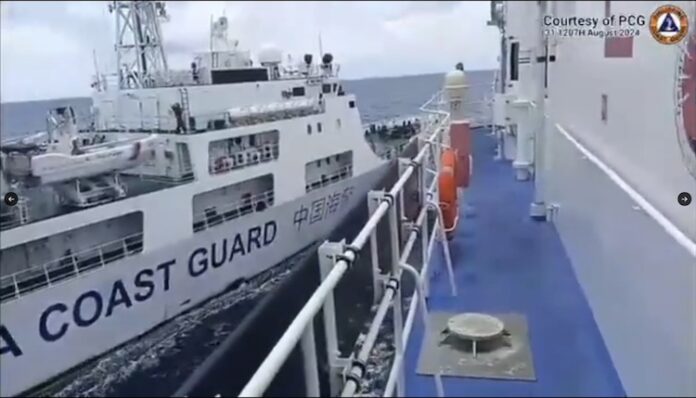
Chinese forces surrounded and rammed the flagship of the Philippine Coast Guard on 31 August 2021 at Escoda Shoal in the seventh scuffle this month between Beijing and Manila in the South China Sea, US Naval Institute News reports.
BRP Teresa Magbanua (MRRV-9701), the Philippine Coast Guard’s flagship and largest patrol ship, was rammed three times by China Coast Guard vessel 5205 around noon. The collisions punched a hole in the Teresa Magbanua’s hull and caused other damage. Multiple Chinese vessels surrounded the 97-meter-long Japanese-made patrol ship, during the fracas, including two Type 837 tugs from the People’s Liberation Army Navy.
mages of the incident from the Philippine Coast Guard show the tugs positioned to the port and starboard sides of Teresa Magabanua. In prior incidents, including one on June 17th, Chinese forces have towed and pushed away Philippine vessels from disputed areas.
Ray Powell, director of the SeaLight Project at Stanford University’s Gordian Knot Center for National Security Innovation, told USNI News that this is the first time he has seen Chinese forces deploy tugs to Escoda. While Powell acknowledged speculation that the tugs were there to push or tow Teresa Magbanua from the shoal, he was unsure “how they would accomplish this unless the ship was first somehow disabled.”
Contrary to the Philippines’ media release, Chinese state media claims that the Philippine Coast Guard caused the incident. A video released by the China Coast Guard claimed that the Philippines “deliberately rammed” their vessel, despite the footage showing the collision occurring on Teresa Magbanua’s stern.
Despite the incident, Manila resolved that it would keep its Coast Guard flagship at Escoda and reiterated its call for restraint from China on the water and in the air in the South China Sea. “We will not succumb to acts of harassment and aggressive behavior,” said a statement from the National Maritime Council.
The flagship of the Philippine Coast Guard has been locked in a standoff with vessels from the China Coast Guard, People’s Liberation Army Navy and China Maritime Militia since arriving at Escoda in April. Manila sent the Coast Guard’s flagship following concerns of a Chinese land reclamation attempt at the maritime feature similar to those seen at Mischief and Subi Reefs, which are now full-fledged military bases. In recent weeks, incidents around Escoda have increased at an alarming frequency, including the ramming of three ships and the blocking of a Philippine resupply mission to the shoal. While Manila was able to resupply Teresa Magbanua with a Coast Guard helicopter on Wednesday, the China Coast Guard warned that further resupply trips by planes or boats could cause future incidents.
China also blockaded a Philippine resupply mission and rammed three Philippine ships in August across the disputed region that China claims under the Ten-Dash Line. There were also three disputed aerial incidents.
As maritime, and aerial disputes step up, the Philippines has expanded its cooperation with old and new partners. Powell noted that these “brazen displays of violence” by China have “succeeded only in uniting its opponents and awakening them to their peril.”
On Friday, Philippine and Vietnamese officials met in Manila and committed to ink a defense agreement before the year’s end. Indo-Pacific Command leadership also visited the Philippines this week for talks about upcoming military exercises and defense exchanges with Washington’s oldest treaty ally in the region. During his visit, Adm. Paparo told reporters that the escort of Philippine vessels in the South China Sea by U.S. forces was an option. However, Armed Forces of the Philippines chief Romeo Brawner stated that Manila would only take up the offer if unilateral efforts failed.



